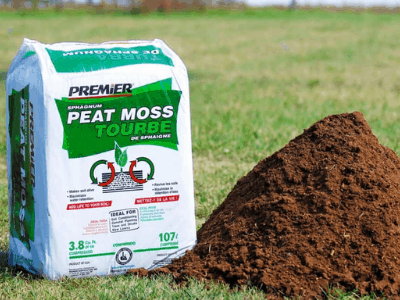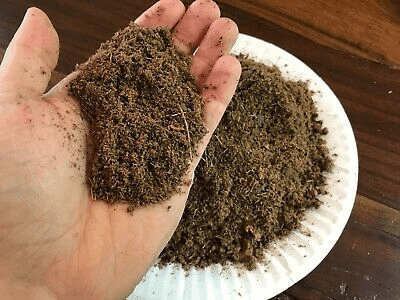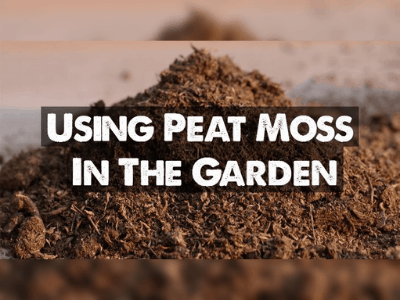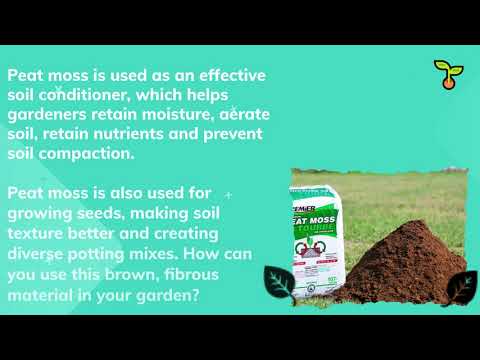
What is Peat Moss
Can We Used Peat Moss As Soil Amendment?
Peat moss is used as an effective soil conditioner,
…which helps gardeners retain moisture, aerate the soil,
…retain nutrients and prevent soil compaction.
Peat moss is also used for growing seeds, making soil texture better…
…and creating diverse potting mixes.
How can you use this brown, fibrous material in your garden?
In this case, peat moss as soil amendment.
What are the many benefits and drawbacks of adding peat moss…
…to garden soil, so you can grow beautiful plants and tasty vegetables?
Are there disadvantages to adding peat moss to garden soil?
The following article is an in-depth explanation of how to use peat moss in gardening soil.
But before that, here we have a story from Jake about his experience using peat moss as soil amendments for his garden.
Let us hear Jake’s story
The day was warm and cloudy, the perfect conditions for a good garden.
I had just finished planting my tomatoes to see when they would start growing.
As I walked back home, I noticed that there were some peat moss bags…
….laying on the ground near my lawn mower.
This made me curious so I picked one up and started reading…
…about what it could do for my garden.
It turns out that this type of moss is great for maintaining moisture…
…in dry soil or an area with low drainage!
After reading this, it seemed like a no-brainer to use this on the soil…
…to make sure my plants grow well during these drought seasons!

Peat moss first became available to gardeners in the mid-1900s, and since then it has revolutionized the way we grow plants. It has a remarkable ability to manage water efficiently and hold on to nutrients that would otherwise leach out of the soil. While performing these amazing tasks, it also improves the texture and consistency of the soil. Keep reading to learn more about peat moss uses.”
Jackie Carroll, author from Gardening Know How
Here’s the main thing!
What is Peat Moss

The decomposed organic matter in bogs is usually moss, sphagnum moss, or lichen.
Once it completely breaks down, it creates a type of soil called peat.
Peat moss as soil amendments has a dark brown, fibrous appearance.
What is Peat Moss Made of?
Peat moss is frequently obtained from sphagnum moss.

Sphagnum moss breaks down over thousands of years…
…when it soaks in water. It can then be produced by drying a bog, and the moss is extracted.
As part of the “making” process, the harvested peat must be dried, screened,
…and then compressed in order to be sold in local garden stores.
Despite being typically considered a non-renewable resource…
…peat moss as soil amendments is harvested as a sustainable method to conserve peat bogs.
Some researchers believe that peat bogs can return to a balanced ecosystem within five to twenty years.
Uses of Peat Moss

Garden soil is amended with peat moss to improve its texture, prevent moisture loss,
…and lighten clay soils.
Additionally, peat moss as soil amendment is used to start seeds, for it to retain water and nutrients,
…as well as to create potting mixes for various houseplants.
Peat Moss As Soil Amendment
In addition to its use as an amendment for garden soil,
…sphagnum peat moss can provide drainage and texture to heavy clay soil.
To make a peat moss as soil amendment you should…
….mix peat moss into sandy soil will help to retain moisture…
…and prevent nutrients from leaching out.
If you have sandy soil in your garden,
…it is difficult to grow various shrubs, bushes, and flowering plants.
Sand usually drains rapidly, taking with it vital nutrients.
Adding peat moss to loamy soil prevents the soil from becoming too infertile.
It is easy for clay soil to become compacted.
Hard, packed soil contains less organic matter which inhibits roots…
….from thriving. Compounding clay soil can also increase the difficulty of water penetration.
Adding peat moss to clay soil helps prevent compaction.
Starting Seeds
It uses aerated soil to allow seeds to germinate quickly and take root.
You can either combine peat moss and perlite…
…or vermiculite to make your own seed starting mix,
…or you can purchase a commercial mix that includes peat moss.
Keep reading…
Make Garden Soil More Acidic
In order to make soil more acidic, you can add peat moss.
Peat moss has a pH of 4.4, therefore if the soil…
….has a high pH, it can be made acidic by adding it.
Peat moss is used to improve the soil, which can last for several…
…years. Rhododendrons, hydrangeas, and camellias do well in acidic soil.
In order to benefit from peat moss without increasing acidity,
…you should add lime to soil to balance pH levels.
Here’s the main thing!
Houseplant Potting Mix
It is common to add peat moss to DIY homemade potting soil mixes.
Houseplant soil can be too dense for potted plants.
A combination of peat moss, potting soil,
…and perlite creates the perfect growing environment for many houseplants.
It is important to amend potting soil with peat moss and perlite to allow water to drain faster….
….as well as light organic matter like peat moss,
…which retains just enough moisture to keep roots hydrated…
…without becoming overly wet or soggy.
Make sure you only add one-third to two-thirds of the peat moss volume…
…to your potting mix before using it as an amendment.
How to Use Peat Moss in the Garden
Gardeners often use peat moss as a vital soil amendment if their soil is too alkaline, compacted…
…or loamy to retain water. Peat moss can increase soil acidity,
…increase water retention, and loosen compacted soil.
Peat moss can be used in garden soil to improve it:
- To make the soil more acidic. Peat moss can be used to increase the acidity of soil by spreading it two inches (five cm) or three inches (seven cm) thick over the planting area, working it into the soil about one foot (30 cm) deep. Thoroughly water the soil before adding plants.
- To amend garden soil. To improve clay or sandy soil texture, spread a thick layer of sphagnum peat moss over the area you intend to plant flowers or shrubs. Sprinkle limestone over the peat to prevent the pH from dropping. Work into the peat up to one foot (30 cm) deep.
Go on…
Advantages of Peat Moss
Peat moss is used in soil because it is a great way to amend different types such as sandy soil,
…clay, and muck.
Because peat moss is relatively light, it is easy to work with,
…and it is readily available in most garden centers or online stores.
Retain moisture in the soil
Peat moss is popular in gardening for its water retention ability.
Adding peat moss to sandy or rocky soil can allow plant roots to get enough moisture.
Sphagnum peat releases moisture gradually…
…which makes it ideal for garden soil and houseplant potting mixes.
Retain Nutrients In The Soil
Although peat moss does not contain many nutrients,
…its water retention properties help to hold nutrients…
…in the soil after heavy rainfall.
This, in turn, increases one of the most important growth factors in fertile soil…
…called the “cation exchange capacity”.
Next…
Doesn’t Contain Weed Seeds or Harmful Bacteria
Furthermore, peat moss does not contain harmful microorganisms,
…making it ideal for growing plants from seeds…
…where bacteria and weed seeds could harm the plants.
It can also be used to amend garden soil…
…to prevent weeds from growing and to improve nutrients for the garden.
Doesn’t compact or break down in the soil
By working in peat moss and other soil amendments, compaction can be prevented.
Over time, clay soil especially becomes dense, preventing water and air from reaching plant roots.
Using peat moss to amend soil ends up resulting in healthier plants.
Next up…
Disadvantages of Peat Moss
Although peat moss is of high quality and is highly beneficial for soil amendments,
…it also has some disadvantages.
In fact, some may argue that some of the benefits come at a price.
It’s important to remember that peat moss lacks many nutrients.
Adding compost or manure to the soil will “feed”…
…the soil for healthy plant growth. Peat moss’s low pH will also affect soil acidity,
…making it too acidic for some plants.
There is also the matter of cost.
Peat moss, especially if you make your own garden compost, is generally more expensive than compost.
Peat Moss vs. Sphagnum Moss
Peat moss and sphagnum moss can be confused with each other.
Sometimes peat moss will be labelled as sphagnum moss.
The difference is that sphagnum moss is living, whereas peat moss is decayed organic material…
…in the bog or wetland. Sphagnum moss has a neutral pH, whereas peat moss is acidic.
Peat moss and sphagnum moss share the same parent plant, but they are thousands of years apart.
There are around 380 species of sphagnum moss, which grows in wetlands or in bogs.
Sphagnum moss dies and decays in the bogs, eventually forming peat moss. In natural bogs…
…where sphagnum moss grows, it takes years to develop peat moss.
Peat Moss vs. Coconut Coir
It holds moisture, lightens the soil, and improves its structure.
Coconut coir is a fibrous organic matter.
Peat moss is also an effective soil amendment.
Despite coconut coir’s sustainability, peat moss retains more water…
…than coconut coir does. Both coconut coir and peat moss contain very few nutrients.
In the debate over which is best, peat moss or coconut coir,
…the origins of the materials are part of the issue.
Coconut fiber is the stringy fibre found in coconut husks. Coconut fibre is continually available…
…and can be used in soil amendments. Check out these comparisons of peat moss and coconut coir.
- Sustainability. As compared to peat moss, coconut coir is more sustainable than peat moss because while it continues to regenerate, it takes a long time before it becomes available. However, a coconut palm plant can yield up to 75 coconuts per year.
- pH levels. The pH range of coconut fiber is 5.2 – 6.8. Therefore, using coconut coir as an amendment doesn’t dramatically change the pH of the soil. However, if you need acidic soil for plant growth, peat moss is more effective.
- Water absorption. Water retention is excellent for both sphagnum peat moss and coconut coir. Peat moss is better in terms of water retention.
- Cost. Each product has a similar price.
Peat Moss vs. Compost
There are significant differences between compost and peat moss,
…even though both materials contain decayed organic matter.
As compost is made quickly from everyday waste, peat moss has fewer nutrients than compost does.
Unlike compost, peat moss does not degrade in the soil. The compost may contain weed seeds.
Unlike peat moss, compost is pH neutral.
Keep reading..
Peat Moss vs. Mulch
It’s not a good idea to use peat moss as mulch.
Mulch is an organic or inorganic material that helps to hold in moisture…
…protect plant roots and keep weeds at bay.
Peat moss absorbs moisture from the soil and blows away easily.
Peat Moss vs. Perlite
With peat moss, perlite is a soil amendment that also provides drainage.
Perlite is a volcanic mineral made up of limestone which holds small amounts of moisture.
Peat moss is also used to keep the soil moist and release moisture when plants need it.
Perlite can be combined with peat moss or bark chips to achieve a well-draining potting mix.
For succulents or cacti that need well-draining soil,
…you can mix 1/3 organic material and 2/3 inorganic matter.
It is possible to adjust the proportions of the ingredients in an all-purpose potting soil recipe…
…by adding more peat moss and organic matter.
Does Peat Moss Break Down?
Unlike other soil amendments, peat moss won’t break down in the soil soon.
After all, it took many years for it to break down in the first place.
This makes peat moss an excellent choice to amend garden soil for many years to come.
Last but not least…
Peat Moss Alternatives
In addition to providing aeration, peat moss improves soil structure,
…and prevents nutrient runoff and provides other benefits when mixed in with garden soil.
Despite the fact that there are enormous peat reserves,
…some people are still concerned about its environmental impact.
For instance, certain countries have banned peat moss harvesting…
…because of concerns about its sustainability.
You can also use peat moss in place of the following alternatives:
Coconut coir. One of the best peat moss alternatives is coconut fibers, which come from the fibrous husks of coconuts, which stem from the processing of coconuts. Due to its similarity to peat moss it is often called coconut peat.
Compost. Compost is also a suitable soil amendment for improving drainage and enhancing the soil’s nutrient profile. It is easy to make at home, and is cheap to purchase. However, it does not break down as fast as peat moss, and must be replaced every year.
Wood materials. In addition to wood chips and composted bark, you are able to aerate and improve the drainage of soil by adding sawdust. However, wood products tend to make soil acidic, come from non-sustainable sources, and may contain chemicals.
Sum Up
Peat moss is mostly used by gardeners as a soil enhancement or as a component of potting soil.
Since it has an acid pH, it’s perfect for acid-loving plants like blueberries and camellias.
Compost could be a better option for plants that prefer more alkaline soil.
One application of peat moss lasts for several years because it does not compress or break down easily.
In contrast to poorly treated compost, peat moss does not contain harmful microorganisms or weed seeds.
Many potting soils and seed starting mediums include peat moss as a key ingredient.
It can hold many times its weight in water and release it as required to the plant roots.
It also holds onto nutrients, preventing them from being washed out of the soil when the plant is watered.
Peat moss is insufficient as a potting medium. It must be blended with other ingredients to make up one-third…
….to two-thirds of the overall mix amount.
Conclusion
Last thing for sure. This plant need to care for carefully, remember all plant need the “love” too.
Alright that’s all for today! Do you have any questions about all of this?
Or do you need to add some method to get rid of molds from houseplants?
Let me know your recommendation from the comment below.
Find out more about gardening from us!
Check out more posts on our website like this one here!
I hope you can now take care your plant and it’s growing big and healthy!
Thanks for reading this article! Bye!

